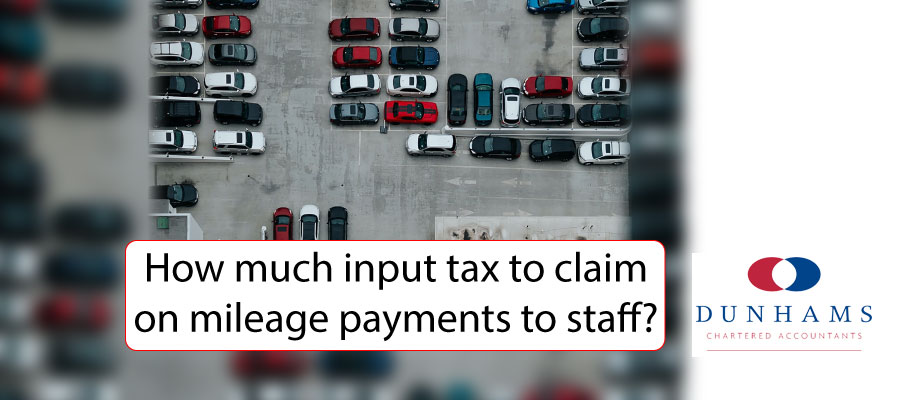
How much input tax to claim on mileage payments to staff?
Posted on: 16-11-2023
How much input tax to claim on mileage payments to staff? – Dunhams News Blogs
You pay a mileage rate to staff who use their private cars for business trips. How much input tax can you claim on these payments and what records must your employees submit with their expenses claim?

Tax-free mileage rates
HMRC allows you to pay your employees 45p per mile for the first 10,000 business miles in a tax year and 25p per mile thereafter without there being any direct tax implications, e.g. a benefit-in-kind charge on the employee. These rates apply to cars and vans; there are lower rates for motorcycles and bikes.
Example. Maria works for a firm of accountants and uses her private car to visit clients. She travelled 12,000 business miles in the tax year ended 5 April 2023. Her employer can pay her 10,000 x 45p plus 2,000 x 25p without any tax implications, i.e. £5,000.
The above mileage rates do not vary according to the size of the vehicle, even though larger vehicles often incur more expenses. However, the single rates will make your calculations easier.
Claiming input tax
The 45p/25p rates compensate your employees for all costs that relate to their vehicles, including repair costs, fuel, wear and tear, and a contribution towards road tax and insurance. However, your business can only claim input tax on the fuel element of the rates, and you have three calculation options here:
- you can work out your own rates per mile based on the size of the vehicle and the average fuel it consumes
- use rates published by motoring organisations such as the AA and RAC which are accepted by HMRC
- use HMRC’s own rates it publishes four times per year, which reflect movements in fuel prices.
HMRC publishes three different rates for cars, depending on the cylinder capacity (cc) of the vehicle: 1,400cc (1,600cc for diesel) or less; 1,401-2,000cc (1,601cc-2,000cc for diesel); greater than 2,000cc. There are separate rates for petrol, diesel and liquefied petroleum gas.
The advisory rates published by HMRC include VAT, so your input tax claim will be 1/6 of the quoted rate rather than 20%.
Depending on your VAT quarters, you might have two different rates to apply on a return. For example, for the quarter ending 31 July 2023, you would apply the rates that applied from 1 March to 31 May 2023 for the first month and the rate from 1 June to 31 August 2023 for the final two months of the quarter. As a concession, HMRC allows you to continue to use the previous rates for one extra month after new rates apply.

What records must you keep?
Your employees must keep receipts/invoices for all of their fuel purchases and attach them to their mileage claims. The invoices must show the supplier’s VAT registration number and how much fuel was purchased etc. Other records needed to support your input tax claim are:
- the mileage travelled and details of the journey and confirmation that it is a business trip
- the cc of the vehicle and the mileage rate paid, as well as the input tax being claimed.
The advisory electric rate for fully electric cars is 10p per mile. Hybrid cars are treated as either petrol or diesel cars for advisory fuel rates. HMRC currently imposes further restrictions on claiming input tax on costs incurred for charging electric vehicles, although its policy is apparently being reviewed.
If you would like any assistance with any of these points.
